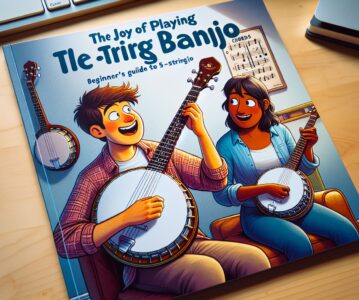Playing a musical instrument is a rewarding and enriching experience, and if you’re considering taking up the banjo, you’re in for a treat! The banjo is a unique string instrument that has found its way into many music genres, including bluegrass, folk, and country. With its distinct twang and rhythmic sound, the banjo can bring joy to both the player and the listener. In this beginner’s guide, we’ll explore the world of the 5-string banjo, from its history and construction to basic playing techniques and helpful tips.
The History and Construction of the 5-String Banjo
The banjo originated from West Africa and made its way to America during the era of slavery. It quickly gained popularity and became an integral part of American music. The 5-string banjo, with its four long strings and shorter fifth string, is the most commonly used banjo variant, especially in bluegrass and folk music.
A typical 5-string banjo consists of several key components. The neck is where you hold the instrument and press down on the strings to produce different pitches. The head is a circular piece of plastic or animal skin that covers the wooden or metal resonator. This resonator amplifies the sound produced by the strings. The bridge, which rests on the head, supports the strings and helps transmit their vibrations to the resonator.
Getting Started: Tuning and Holding the Banjo
Before diving into playing the banjo, it’s important to know how to tune it correctly. The most common tuning for the 5-string banjo is called “open G” tuning. From the lowest pitched string (the one closest to your body as you hold the banjo), tune the strings to the notes D, G, B, D, and G.
Once your banjo is in tune, it’s time to learn the proper way to hold it. Sit in a chair with a straight back, and rest the banjo on your lap, angling the neck upward. Use your left hand to hold the neck, and your right hand to strum or fingerpick the strings. Keeping the banjo stable and at a comfortable angle will make playing easier and more enjoyable.
Basic Playing Techniques
To produce clear and pleasant sounds on the banjo, it’s crucial to master some fundamental techniques. Let’s explore a few of them:
-
Strumming: Strumming is the most basic banjo technique. Use your right hand to brush your fingertips or a pick across the strings in a downward motion. Aim for consistent, even strokes to achieve a pleasant sound.
-
Fingerpicking: Fingerpicking involves plucking the strings using your right hand fingers individually. Start by using your thumb to pluck the lowest pitched string, and use your index, middle, and ring fingers to pluck the other strings in order.
-
Chords: Chords are an essential aspect of playing any musical instrument. With the banjo, common chords include G, C, and D. Practice transitioning between these chords smoothly, as they form the foundation of many songs.
-
Rolls: Rolls are a series of precisely timed and coordinated fingerpicking patterns that create a flowing and melodic sound. The forward roll, backward roll, and forward-reverse roll are some of the most commonly used rolls in banjo playing. Practice these rolls slowly and gradually increase your speed as you become more comfortable.
Helpful Tips for Banjo Beginners
Learning to play the banjo takes time, patience, and dedication. Here are a few tips to help you on your banjo journey:
-
Start Slow: Don’t rush! Take your time to learn and master the basics before advancing to more complex techniques. Building a strong foundation will pay off in the long run.
-
Practice Regularly: Consistency is key. Try to establish a practice routine and allocate a specific time each day to play the banjo. Regular practice will help you progress faster and retain what you’ve learned.
-
Listen to Banjo Music: Immerse yourself in the world of banjo by listening to banjo artists and various genres that feature the instrument. This exposure will help you develop your musical ear and inspire new ideas for your own playing.
-
Join a Community: Seek out fellow banjo enthusiasts! Join online forums, social media groups, or local music communities where you can exchange tips, seek guidance, and share your progress. Connecting with like-minded individuals can be both motivating and educational.
Conclusion
Learning to play the 5-string banjo can be a truly fulfilling experience. From its historical roots to the essential techniques needed to play, this beginner’s guide has introduced you to the world of banjo playing. Remember to start with proper tuning and correct posture, and gradually work on developing your strumming, fingerpicking, and chord-playing abilities. With patience and practice, you’ll find yourself strumming beautiful melodies and embracing the joy that comes with playing the banjo. So, pick up your banjo, let your fingers dance on the strings, and let the music fill your heart!


